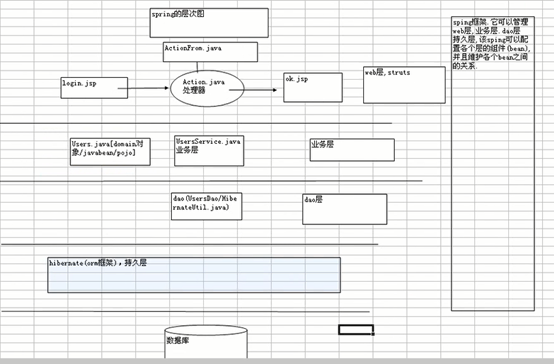1.什么是IOC?
IOC概念:inverse of Controll,控制反转,所谓控制反转,就是把创建对象和维护对象关系的权利从程序中转移到spring的容器中(applicationContext.xml),而程序本身不再维护
2.什么是di?
dependency injection,依赖注入,di和IOC是一个概念,spring的设计者认为di等更能准确表达spring
3.学习框架,最主要的就是学习各个配置
4.spring层次图

5.初次相遇spring,我的看法:
刚刚接触spring,素问spring是一个非常强大的框架,现在一看果然,他能够创建并管理几乎所有的bean对象,这里的bean对象包括:domain,dao,javabean,service...
它就像是一个工程师,协调各个框架(springMVC,struts,hibernate......),注入灵魂,从而创建出一个个伟大的项目,
6.搭建spring项目简单步骤:
1),导入jar包,spring.jar(这个包包含spring框架常用的包),common-logging.jar为日志包,前面两个包为必须,其余包按照需求选择导入

2),在src目录下建立文件applicationContext.xml,一般都是在这个目录下配置,,并且名字为applicationContext.xml,部分开发人员也喜欢使用beans.xml这个名字
3),根据项目需要创建相关的类,并且配置到配置文件applicationContext.xml文件中,配置到配置文件中的类必须满足javabean类的规格
7.简单案例,对比使用传统方法和使用spring框架输出"hello,爱华顿g":

package com.ahd.service; public class UserService { private String username; public String getUsername() { return username; } public void setUsername(String username) { this.username = username; } public void sayHello(){ System.out.println("hello "+username); } }
src目录下建立applicationContext.xml文件
<?xml version="1.0" encoding="UTF-8"?> <beans xmlns="http://www.springframework.org/schema/beans" xmlns:xsi="http://www.w3.org/2001/XMLSchema-instance" xmlns:context="http://www.springframework.org/schema/context" xmlns:tx="http://www.springframework.org/schema/tx" xsi:schemaLocation="http://www.springframework.org/schema/beans http://www.springframework.org/schema/beans/spring-beans-2.5.xsd http://www.springframework.org/schema/context http://www.springframework.org/schema/context/spring-context-2.5.xsd http://www.springframework.org/schema/tx http://www.springframework.org/schema/tx/spring-tx-2.5.xsd"> <!-- 在容器文件中配置数据源(bean/entity/service/dao/pojo) --> <!-- bean元素的作用是当spring框架加载的时候,spring会自动为bean类 UserService类的属性设置值 id就是创建对象的对象名 --> <bean id="userService" class="com.ahd.service.UserService"> <!—name对应java类中的属性,value是赋值--!> <property name="username"> <value>爱华顿g</value> </property> </bean> </beans>
测试类Test
package com.ahd.test; import static org.junit.Assert.*; import com.ahd.service.UserService; public class Test { @org.junit.Test public void test() { //不使用spring框架,使用传统编程方法 //1.创建对象 UserService userService=new UserService(); //2.设置属性 userService.setUsername("爱华顿g"); //3.调用方法 userService.sayHello(); } @org.junit.Test public void test1(){ //使用spring来完成上面的流程 //1.得到spring的容器对象ApplicationContext ApplicationContext ac=new ClassPathXmlApplicationContext("applicationContext.xml"); //2.获取bean对象 UserService us=(UserService) ac.getBean("userService"); //3.调用方法 us.sayHello(); } }
结果截图:

